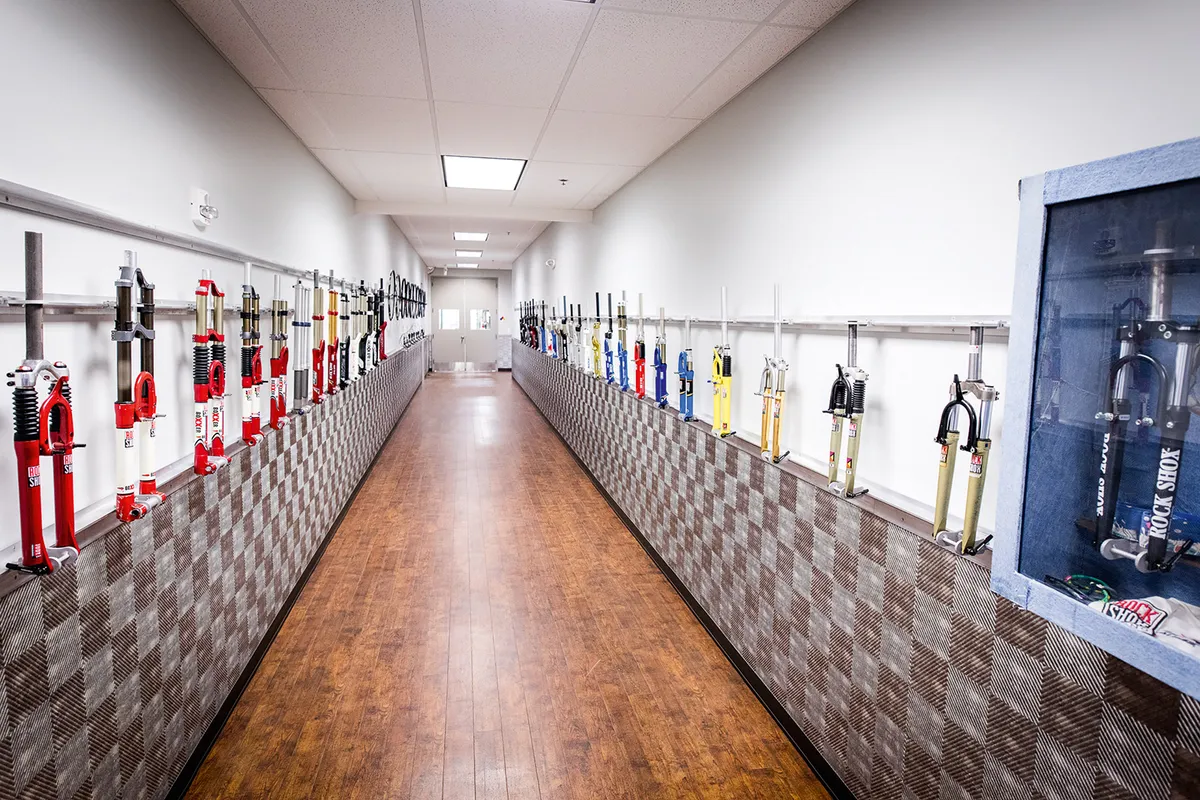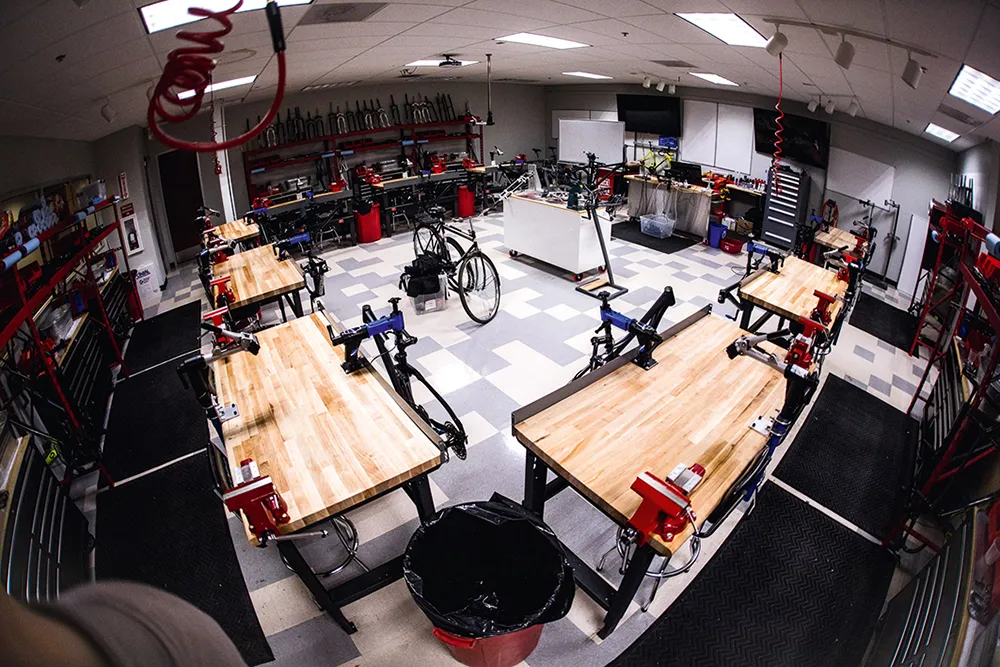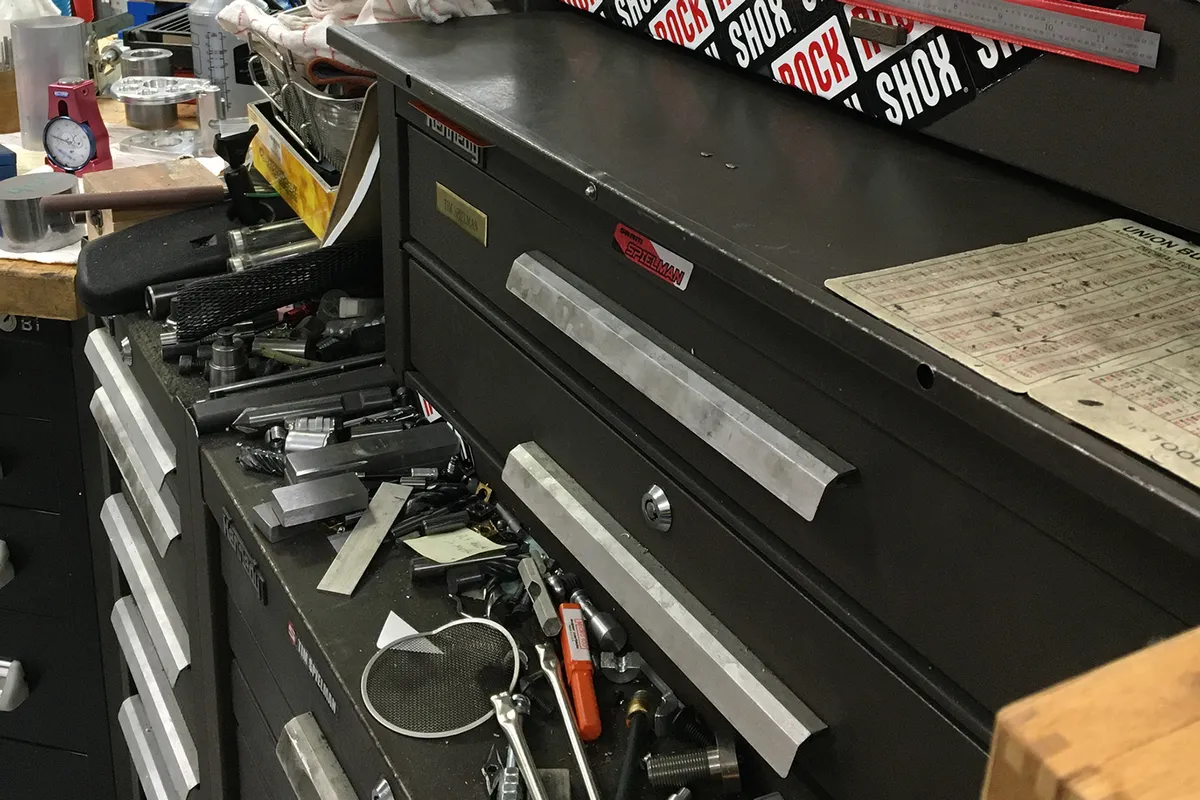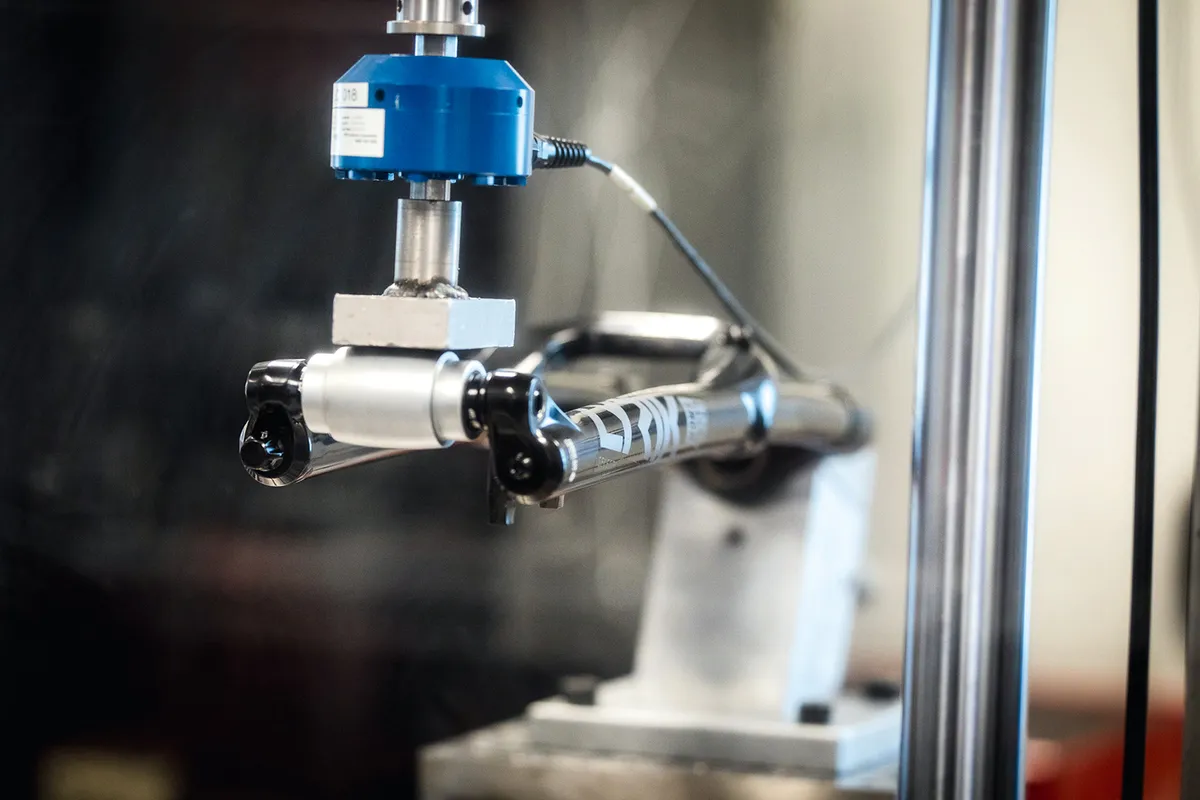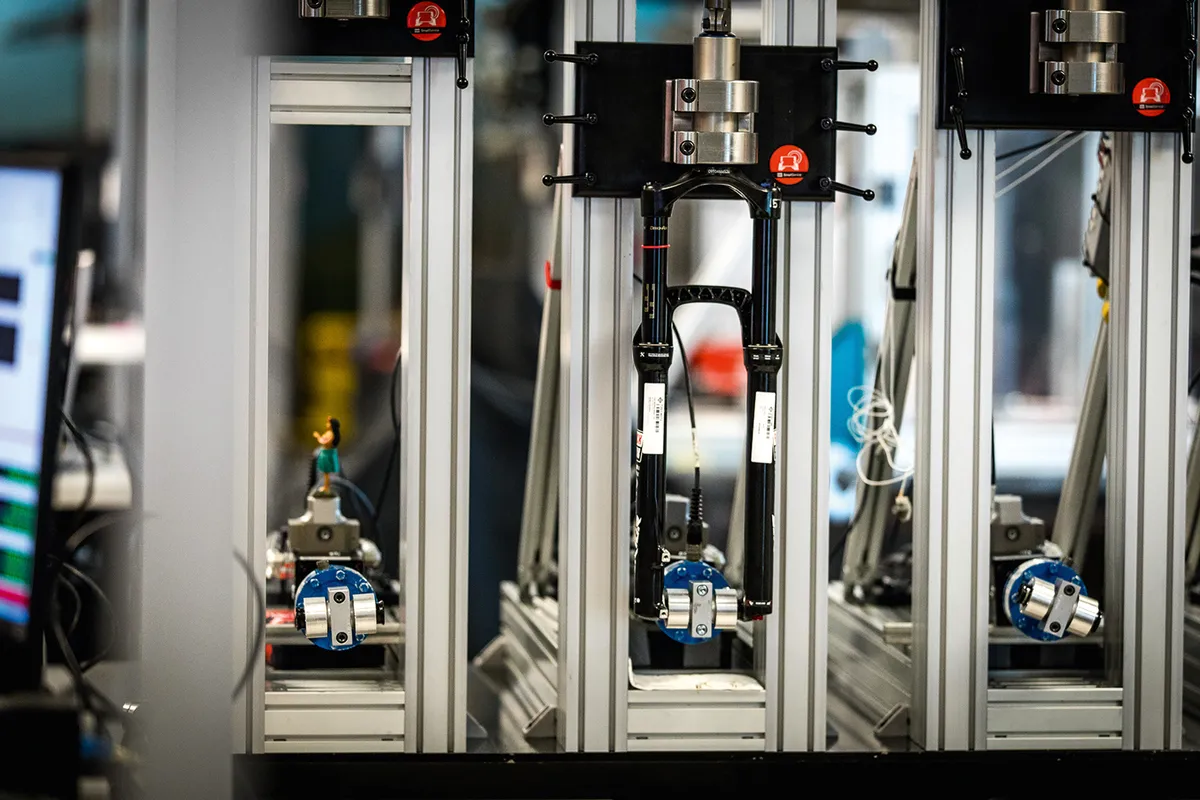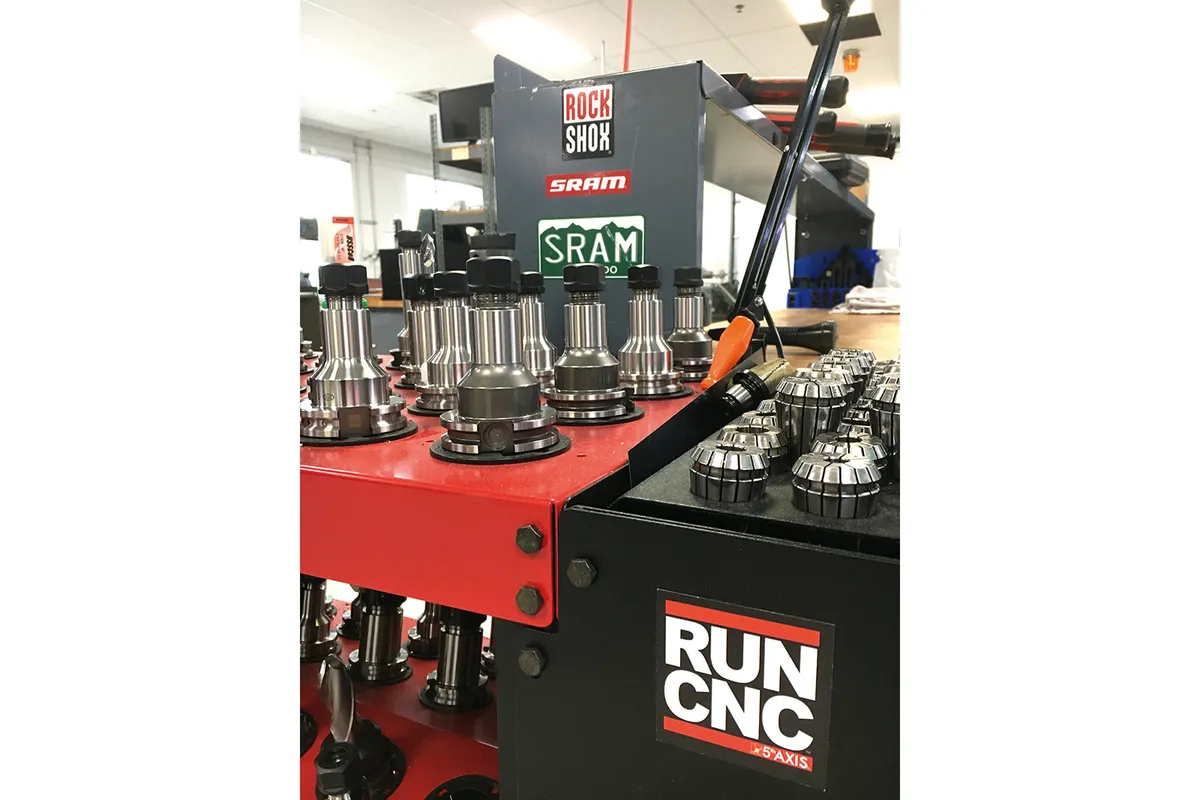While we’re out front showing the public a new set of forks, upstairs in the truck we’re already talking about what’s to come in two years,” says RockShox’ Jon Cancellier, signalling to a point he’s drawn on a timeline that spans the length of the room.
As product manager for one of the world’s leading suspension manufacturers, Jon’s explaining how the bike industry works – the crystal ball gazing that brands have to do to predict the next big trends.
We’re sitting deep in the bowels of SRAM’s Colorado Springs HQ (RockShox was taken over by SRAM in 2002). It’s taken a transatlantic flight, a big dose of jet lag and bad coffee, and the signing of a non-disclosure agreement to get here, but now the door’s shut behind us and we’ve sworn not to reveal their secrets, the crew at RockShox is getting ready to reveal all.
We’re here to discover how a suspension fork is made – what it takes to go from a scribble on a beer mat to a fully tested production product.
- The 2021 RockShox ZEB fork is cheaper and lighter than Fox’s new 38
- Fox Suspension launches brand new 38 enduro fork
- RockShox suspension fork buyer's guide
SIDs and snowstorms
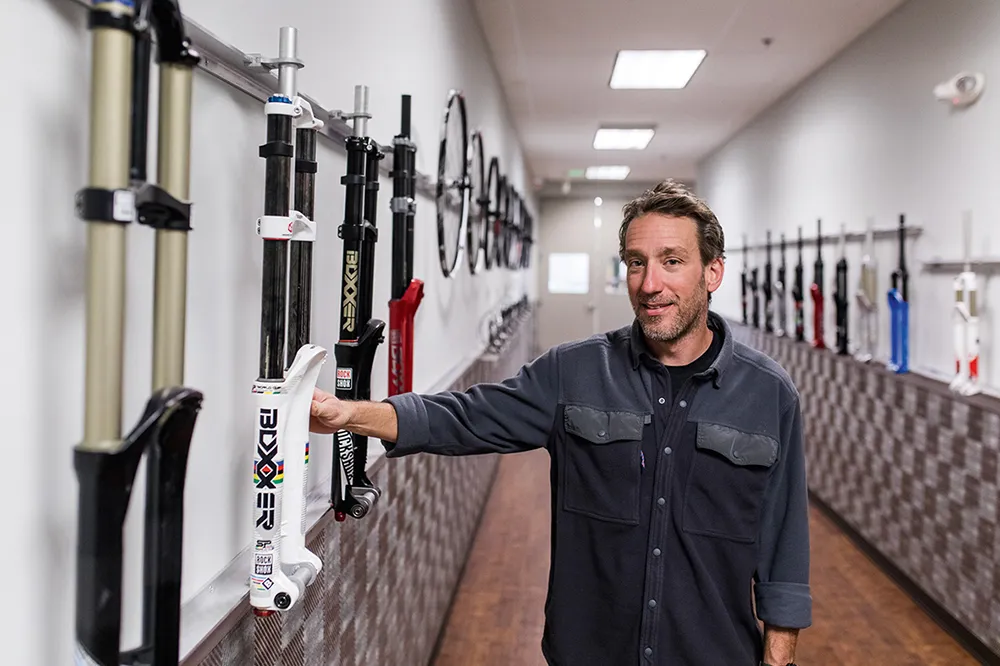
The fork that Jon and his fellow product manager Jed Douglas have been showing us today is RockShox’ new flagship cross-country model, the SID, which came to market earlier this year. But, to put the story into context, we need to rewind all the way back to 1989 when RockShox launched its first fork, the RS-1 – a 60mm-travel, steel-tubed twiglet by modern standards.
Creating a new-generation fork like the SID doesn’t just take two years – it’s the culmination of three decades of development, testing, racing and redevelopment. “Our location is ideal because we can prototype something here, build it here and test it out the back door,” explains Jon, gesturing to rooms off the corridor we’re walking through.
Having arrived by car in the midst of a snowstorm, we have to take his word for it, but he assures us that behind the blanket of clouds is a network of trails that wind their way up into the hills.
Along the walls hang souvenirs of RockShox’ history – one-off special editions made for the Beijing and Sydney Olympics, Steve Peat’s World Champs-winning BoXXer dual-crown, an inverted DH concept fork and lots more.
Jon had a big hand in building many of these, as one of the key players behind RockShox’ hush-hush BlackBox race programme. When Sam Hill or Danny Hart would roll out of the pits at a World Cup on an all-black fork with the BlackBox moniker, you just knew there was something cutting-edge going on inside.
Pretty much every fork on their bikes, and those of many other top racers, started life in this building and probably went through the machine shop we’re on our way to visit.
We ask the bike brands, ‘Hey, what are you working on next?’ and we compile feedback from our consumers and sponsored riders to come up with lists of ideas
Jon Cancellier
Through a door marked ‘SRAM employees only, no photography’ we’re ushered into RockShox’ prototyping department, where banks of CNC machines are positioned alongside workbenches arranged with tool heads, drill bits and billets of aluminium in systematic neatness. Any time a design engineer comes up with an idea, this is where it comes first.
Within these four walls is the capability to make just about anything, but half of the challenge isn’t the mechanics of how you turn a computer model into a 3D part, it’s deciding where time and resources should be focused. This is where Jon and Jed come in.
“We try to get an insight into where the industry is headed,” explains Jon. “We ask the bike brands, ‘Hey, what are you working on next?’ and we compile feedback from our consumers and sponsored riders to come up with lists of ideas, which might be for new products or just a tiny feature to change.”
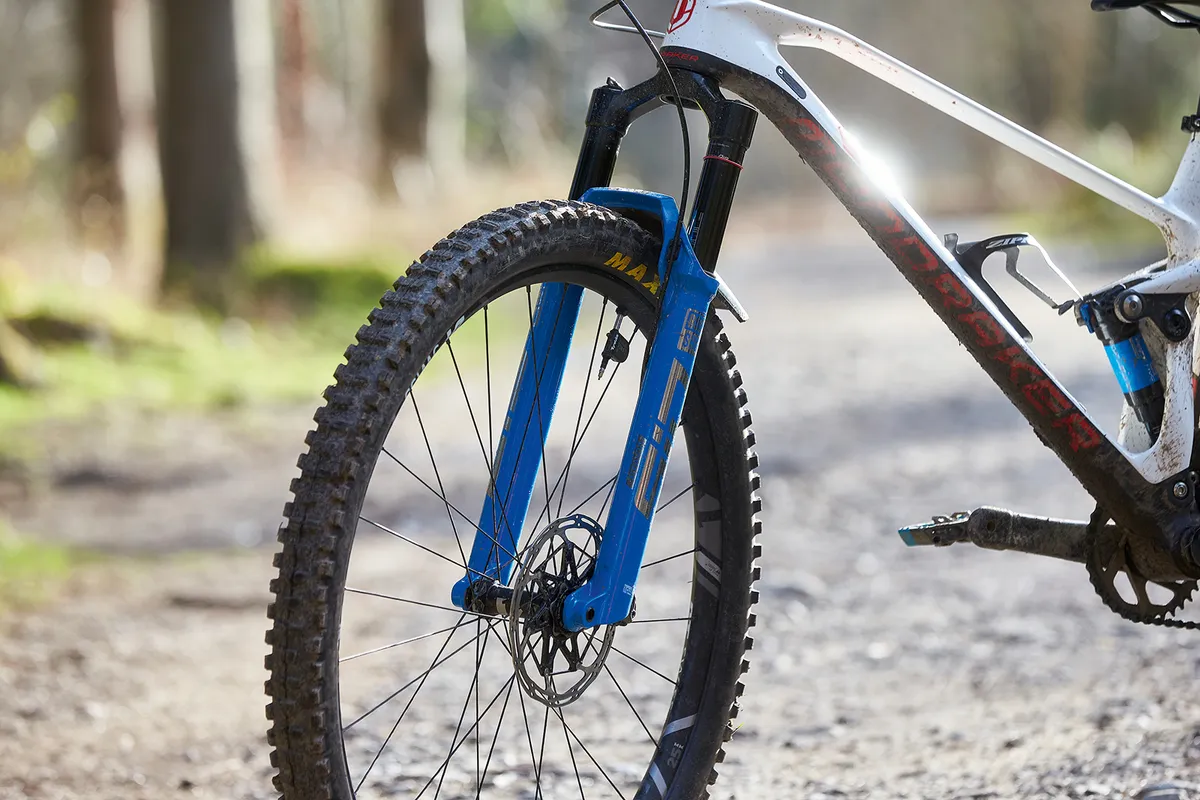
Enter the Advanced Development team. Their job is simply to experiment, to investigate advancements in materials and technology, and see how improvements can be made.
Chances are, if you’ve ever looked at a drivetrain or suspension product and wondered, ‘Why isn’t it done like this?’ then there’s probably a good reason because, guaranteed, the guys here will have trialled it at some stage.
Yesterday, we sat down with the head of SRAM’s Advanced Development in Chicago, Kevin Wesling, and he unearthed a whole box of hare-brained ideas to show us – pedals with offset axles and concept drivetrain parts, as well as more recognisable components, including an early prototype for the Motion Control damper.
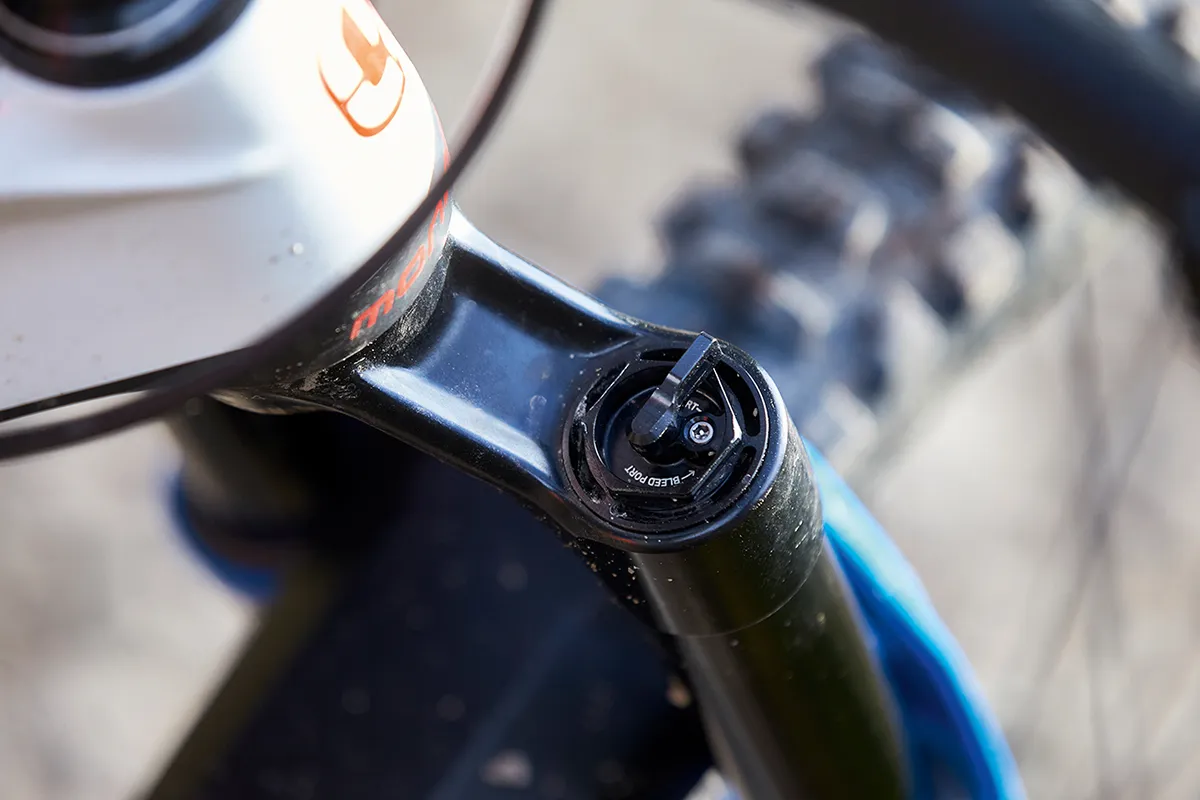
Our favourite was a voice-activated helmet, made when SRAM was developing its electronic eTap and AXS drivetrains. Apparently, the microphone struggled with the commands ‘up’ and ‘down’, so they had to reprogram it and rode around the streets of Chicago shouting ‘peanut butter’ and ‘jelly’!
RockShox’ insight for the new SID was that the world of XC was dividing. Top-level racers were still seeking marginal gains from ever lighter and better-performing suspension, but a new breed of aggressive all-mountain rider was emerging, who wanted a harder-hitting bike that could still cover big miles fast.
“We decided two separate models of SID were required,” Jed explains. “After that, our job was to define every requirement of the forks, and accompanying shocks, to the engineers in minute detail.”
Conception to production
Once the team has come up with a list of criteria, it’ll set a release date when it wants the product to go on sale and everything else works backwards from that. A cycle of pilot builds, testing and refinement then begins, with a design typically going through five or so iterations before it hits the shelves.
In the case of the SID this took around 12 months, but bigger projects, such as the integration of electronics into the AXS drivetrain, will take several years.
The huge benefit for RockShox of having a fully-equipped machine shop within spitting distance of the engineers’ desks is that they can try out ideas almost instantaneously. Something can go from a CAD model on-screen to being bolted onto a bike and ridden on the local hill within a matter of days.
“Ride the trails in Ute Valley Park and I bet you could spot something new and unreleased from SRAM on any day of the week,” laughs Jon. “We’ve learned that the secret when someone stops you for a chat is to divert attention away by asking them about their bike!”
Since entering the prototyping workshop, we’ve been trying our hardest to catch a glimpse of any undisclosed items absently left lying around, but we’re distracted by the introduction of head machinist Joel Dahlberg, who arrives to show us around.
What can be created here from a simple block of aluminium is seriously impressive, and a complete set of fork lowers can be intricately machined and bored out using a massive five-axis milling machine. Translucent plastic models of brake and suspension parts – called ‘clear studies’ – are also made to examine the flow of oil and highlight where issues might arise.
The Peaty test
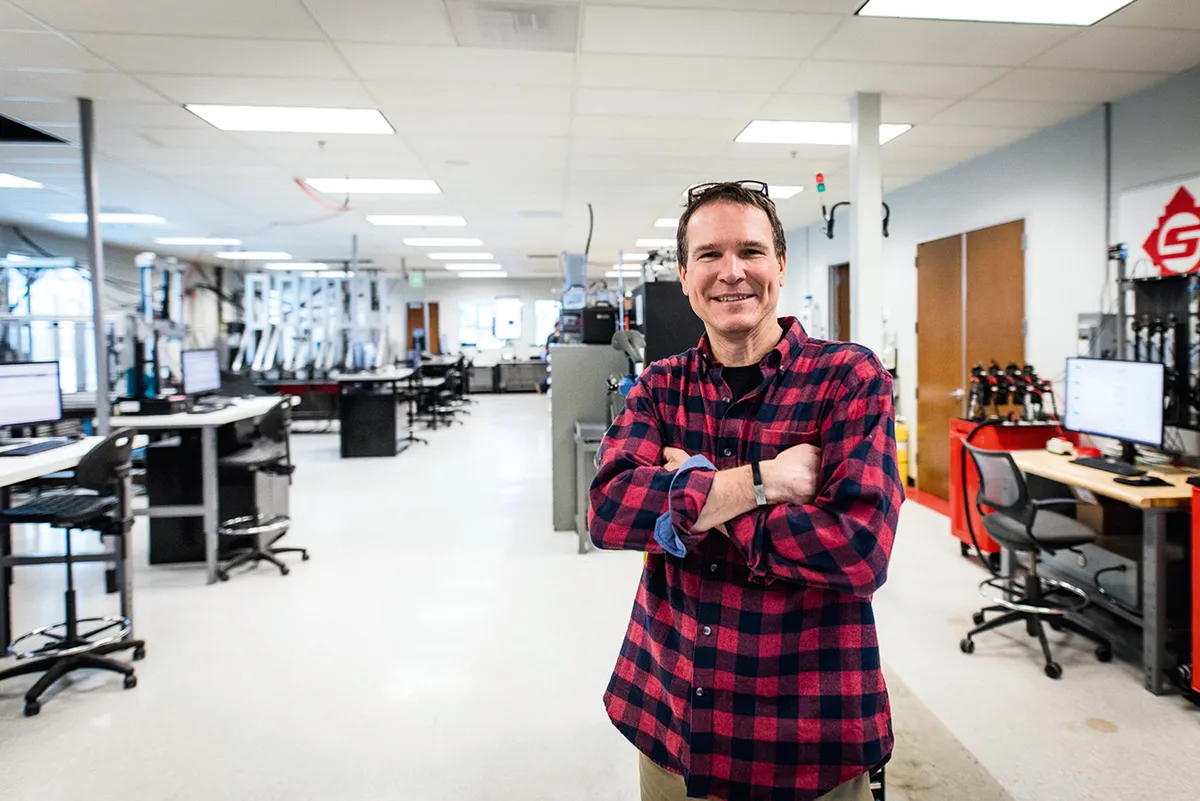
Another role of the workshop is to build the proprietary test rigs used next door to push prototypes beyond their limits. “This is the coolest area of SRAM ’cause we get to break stuff!” says chief testing technician Eric Cefus, holding the door open to his mad scientist’s lair.
Above the hiss of hydraulics, there’s the clanking of various mean-looking machines whose sole purpose is to inflict torture on bicycle parts – bending them out of shape, dropping weights on them, boiling or freezing them, or cycling them through their motions until they give up the ghost.
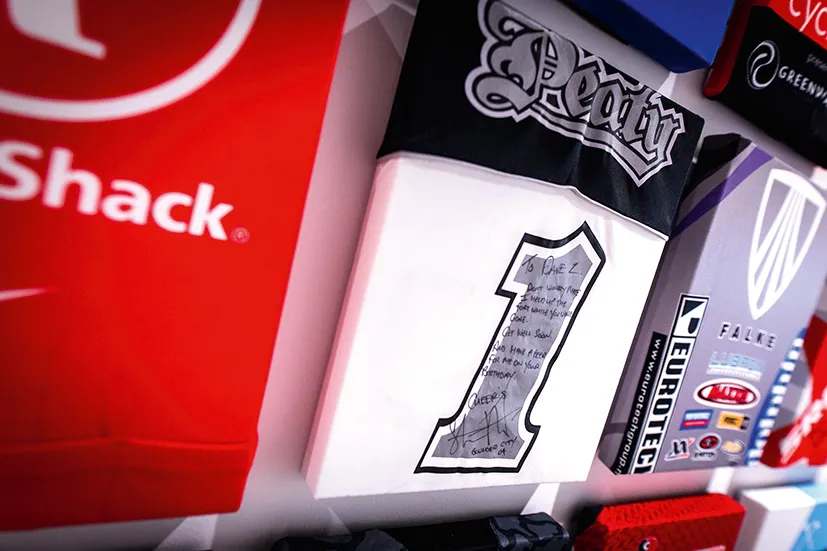
Our eye is caught by a dyno machine that looks to be rattling a fork to pieces. “This is programmed with one of Peaty’s World Cup runs,” explains Eric.
“We recorded the telemetry data and it’s got everything you could imagine subjecting a fork to.” Which, as it turns out, is 90kg of Sheffield Steel charging down the hill at full tilt.
Another device is slowly bending a fork backwards to simulate what happens when you slam into obstacles. Unbelievably, the fork deflects by over 20cm before springing back straight, so the next time you plough into a rock at full speed, be more worried about what will happen to you than your bike!
If a prototype fork can make it through all this unscathed, then it’s fully dissected and parameters such as oil leakage are measured to 0.1 of a gram. Those that don’t make the grade end up in a skip in the corner; a graveyard for mangled test samples.
“We’ve had instances where these parts have found their way onto eBay,” admits Eric, “so now we do everything we can to prevent that. We GPS-track the recycling truck that comes to pick them up.”
By the time a fork has gone through three cycles of being built, abused, revised and rebuilt, it should be pretty close to ready for production. Providing it gets the thumbs-up from both the lab and in real-world tests, then it’s time for the Colorado office to talk to their partners in the Far East and initiate some pilot runs.
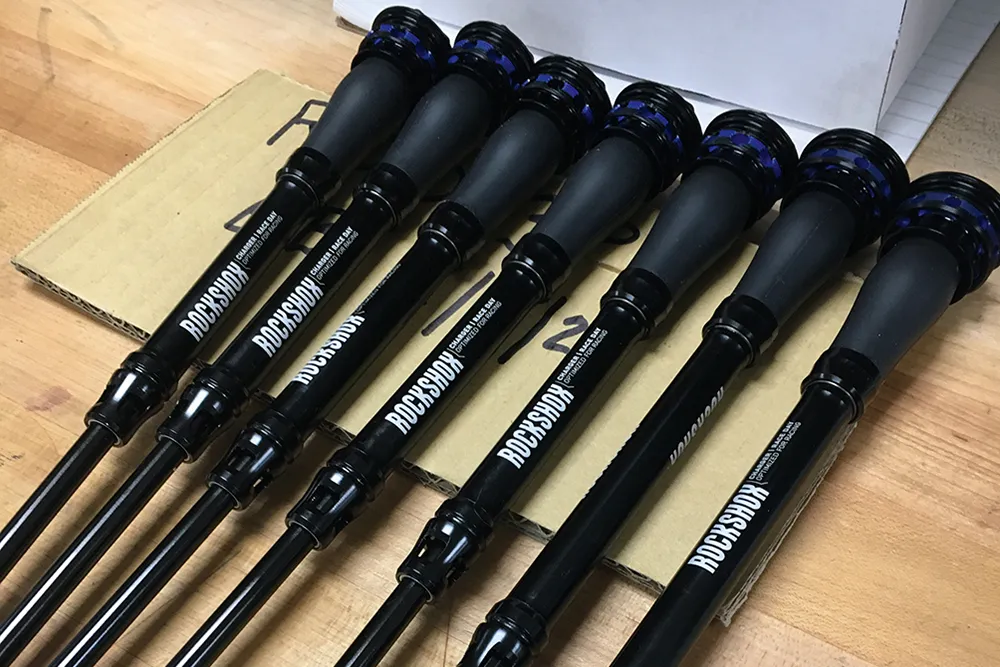
Jed explains that because the SID’s new Charger Race Day damper is comprised of so many intricate parts that are tricky to assemble, they wanted to give the factory as much practice as possible. “And when the fork’s got new lower legs as well,” he continues, “it can take two months from us issuing a design to our supplier to them creating the tools they need and sending us back a sample product.”
Once this has happened and the Colorado office have a test batch of forks, they’ll tear them apart and examine them against a huge checklist of criteria. If they’re up to scratch then the message will go out for a bigger quantity and the process will be repeated.
You can’t make the public wait or they’ll forget about it and spend their money on something else
Jon Cancellier
So, when it’s time to push the button on production, RockShox can be confident that the forks rolling off the line will be exactly as it expects.
Alongside this, while the engineering team is working on the nuts and bolts, Jon and Jed will be out on the road trying to sell the product to bike brands.
“I spent the entirety of last summer packing my bike in and out of a bag and riding with our customers,” recalls Jon. More often than not, in the early days he won’t even have a final product to show them, but it’s his job to get the new SID on bikes and convince the brands it’s the real deal, and also to collate any last-minute feedback that might be incorporated.
The big reveal
All this happens behind the scenes, and the first sniff we get that a new fork or shock is on the horizon is usually when production is underway.
The goal of any company launching a new product is that, when the curtain is finally lifted, the product is already in the shops and ready to buy. “You can’t make the public wait,” says Jon, “or they’ll forget about it and spend their money on something else.”
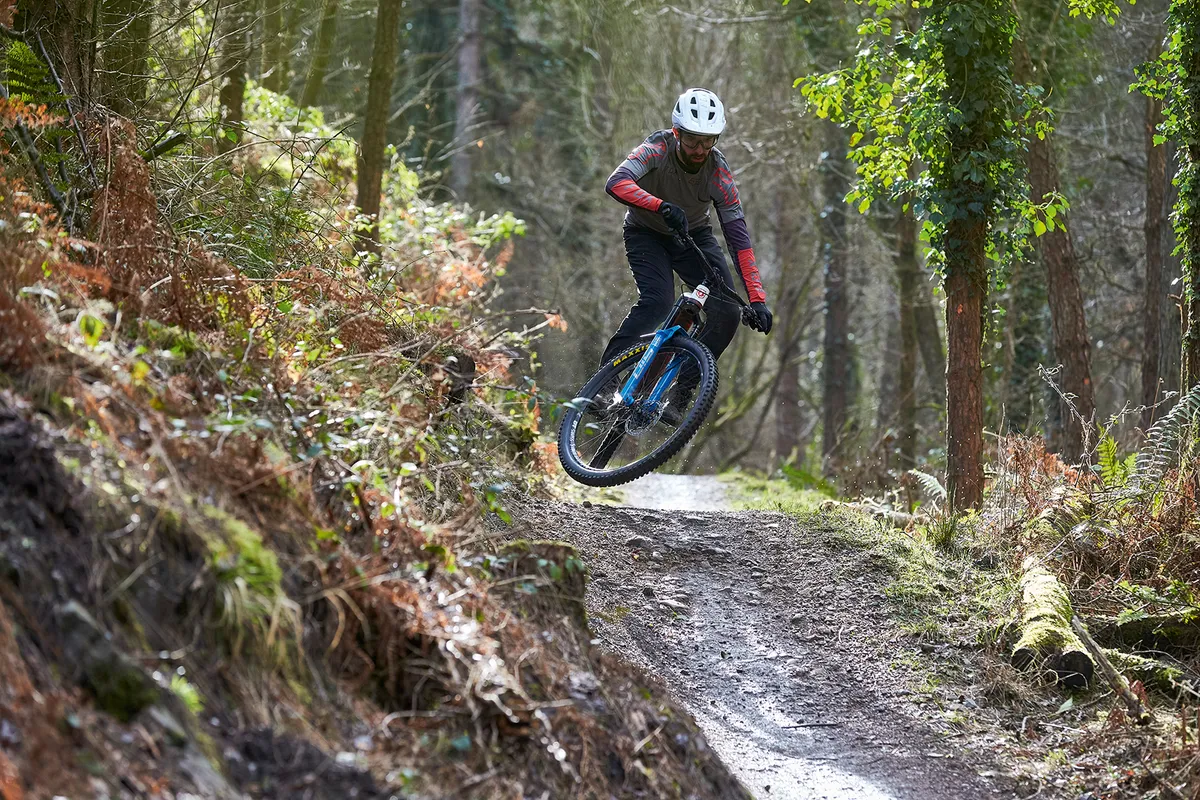
But, as Jon explained to us at the outset, what we see as this exciting new product is already old news to them. Their sights are set on the future, predicting the next mountain biking trends. When Paul Turner created the original RS-1 in 1989, it would’ve been hard for him to imagine that, 30 years down the line, the RockShox range would include forks and shocks for specific duties, with progressive air springs and highly-tunable dampers.
The same for SRAM. In the mid ’80s, when founders Stan Day and Sam Paterson came up with the Grip Shift concept, could they ever have envisioned it would lead to wireless electronic shifting that can be analysed by a smartphone app?
Today the scope for innovation is greater than ever, with both RockShox and SRAM operating under one roof here in Colorado, and highly specialised engineers working side by side on everything from materials to fluid dynamics and electronics.
By now we’ve come full circle on our tour. We’ve seen the historical developments leading up to the present day, and we’ve witnessed first-hand how the latest products are designed, prototyped and tested. As for what’s coming next, we can’t tell you that, but you’ll find out very soon because somewhere in the world a factory is already making it.
